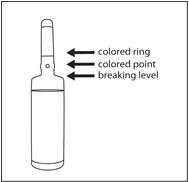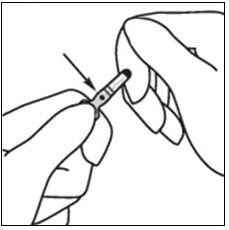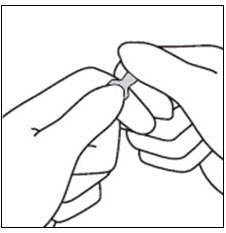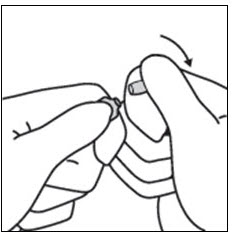HALDOL DECANOATE Solution for injection Ref.[27461] Active ingredients: Haloperidol
Source: FDA, National Drug Code (US) Revision Year: 2020
3. Indications and Usage
HALDOL decanoate 50 and HALDOL decanoate 100 are indicated for the treatment of patients with schizophrenia who require prolonged parenteral antipsychotic therapy.
10. Dosage and Administration
HALDOL decanoate 50 and HALDOL decanoate 100 should be administered by deep intramuscular injection. A 21 gauge needle is recommended. The maximum volume per injection site should not exceed 3 mL. DO NOT ADMINISTER INTRAVENOUSLY.
Parenteral drug products should be inspected visually for particulate matter and discoloration prior to administration, whenever solution and container permit.
HALDOL decanoate 50 and HALDOL decanoate 100 are intended for use in schizophrenic patients who require prolonged parenteral antipsychotic therapy. These patients must be previously stabilized on antipsychotic medication before considering a conversion to haloperidol decanoate. Furthermore, it is recommended that patients being considered for haloperidol decanoate therapy have been treated with, and tolerate well, short-acting HALDOL (haloperidol) in order to reduce the possibility of an unexpected adverse sensitivity to haloperidol. Close clinical supervision is required during the initial period of dose adjustment in order to minimize the risk of overdosage or reappearance of psychotic symptoms before the next injection. During dose adjustment or episodes of exacerbation of symptoms of schizophrenia, haloperidol decanoate therapy can be supplemented with short-acting forms of haloperidol.
The dose of HALDOL decanoate 50 or HALDOL decanoate 100 should be expressed in terms of its haloperidol content. The starting dose of haloperidol decanoate should be based on the patient’s age, clinical history, physical condition, and response to previous antipsychotic therapy. The preferred approach to determining the minimum effective dose is to begin with lower initial doses and to adjust the dose upward as needed. For patients previously maintained on low doses of antipsychotics (e.g. up to the equivalent of 10 mg/day oral haloperidol), it is recommended that the initial dose of haloperidol decanoate be 10–15 times the previous daily dose in oral haloperidol equivalents; limited clinical experience suggests that lower initial doses may be adequate.
Initial Therapy
Conversion from oral haloperidol to haloperidol decanoate can be achieved by using an initial dose of haloperidol decanoate that is 10 to 20 times the previous daily dose in oral haloperidol equivalents.
In patients who are elderly, debilitated, or stable on low doses of oral haloperidol (e.g. up to the equivalent of 10 mg/day oral haloperidol), a range of 10 to 15 times the previous daily dose in oral haloperidol equivalents is appropriate for initial conversion.
In patients previously maintained on higher doses of antipsychotics for whom a low dose approach risks recurrence of psychiatric decompensation and in patients whose long-term use of haloperidol has resulted in a tolerance to the drug, 20 times the previous daily dose in oral haloperidol equivalents should be considered for initial conversion, with downward titration on succeeding injections.
The initial dose of haloperidol decanoate should not exceed 100 mg regardless of previous antipsychotic dose requirements. If, therefore, conversion requires more than 100 mg of haloperidol decanoate as an initial dose, that dose should be administered in two injections, i.e. a maximum of 100 mg initially followed by the balance in 3 to 7 days.
Maintenance Therapy
The maintenance dosage of haloperidol decanoate must be individualized with titration upward or downward based on therapeutic response. The usual maintenance range is 10 to 15 times the previous daily dose in oral haloperidol equivalents dependent on the clinical response of the patient.
HALDOL DECANOATE DOSING RECOMMENDATIONS:
| Monthly | ||
|---|---|---|
| Patients | 1st Month | Maintenance |
| Stabilized on low daily oral doses (up to 10 mg/day) | 10–15 × Daily Oral Dose | 10–15 × Previous Daily Oral Dose |
| Elderly or Debilitated | ||
| High dose Risk of relapse | 20 × Daily Oral Dose | 10–15 × Previous Daily Oral Dose |
| Tolerant to oral haloperidol | ||
Close clinical supervision is required during initiation and stabilization of haloperidol decanoate therapy. Haloperidol decanoate is usually administered monthly or every 4 weeks. However, variation in patient response may dictate a need for adjustment of the dosing interval as well as the dose (see CLINICAL PHARMACOLOGY).
Clinical experience with haloperidol decanoate at doses greater than 450 mg per month has been limited.
INSTRUCTIONS FOR OPENING AMPULE
1. Medication often rests in the top part of the ampule. Before breaking the ampule, lightly tap the top of the ampule with your finger until all fluid moves to the bottom portion of the ampule. The ampule has a colored ring(s) and colored point which aids in the placement of fingers while breaking the ampule.
Step 1:
2. Hold the ampule between thumb and index finger with the colored point facing you.
Step 2:
3. Position the index finger of the other hand to support the neck of the ampule. Position the thumb so that it covers the colored point and is parallel to the colored ring(s).
Step 3:
Keeping the thumb on the colored point and with the index fingers close together, apply firm pressure on the colored point in the direction of the arrow to snap the ampule open.
Step 4:
9. Overdosage
While overdosage is less likely to occur with a parenteral than with an oral medication, information pertaining to HALDOL (haloperidol) is presented, modified only to reflect the extended duration of action of haloperidol decanoate.
Manifestations
In general, the symptoms of overdosage would be an exaggeration of known pharmacologic effects and adverse reactions, the most prominent of which would be: 1) severe extrapyramidal reactions, 2) hypotension, or 3) sedation. The patient would appear comatose with respiratory depression and hypotension which could be severe enough to produce a shock-like state. The extrapyramidal reactions would be manifested by muscular weakness or rigidity and a generalized or localized tremor, as demonstrated by the akinetic or agitans types, respectively. With accidental overdosage, hypertension rather than hypotension occurred in a two-year old child. The risk of ECG changes associated with torsade de pointes should be considered.
(For further information regarding torsade de pointes, please refer to ADVERSE REACTIONS.)
Treatment
Since there is no specific antidote, treatment is primarily supportive. Dialysis is not recommended in the treatment of overdose because it removes only very small amounts of haloperidol. A patent airway must be established by use of an oropharyngeal airway or endotracheal tube or, in prolonged cases of coma, by tracheostomy. Respiratory depression may be counteracted by artificial respiration and mechanical respirators. Hypotension and circulatory collapse may be counteracted by use of intravenous fluids, plasma, or concentrated albumin, and vasopressor agents such as metaraminol, phenylephrine and norepinephrine. Epinephrine must not be used. In case of severe extrapyramidal reactions, antiparkinson medication should be administered, and should be continued for several weeks, and then withdrawn gradually as extrapyramidal symptoms may emerge. ECG and vital signs should be monitored especially for signs of Q-Tc interval prolongation or dysrhythmias and monitoring should continue until the ECG is normal. Severe arrhythmias should be treated with appropriate anti-arrhythmic measures.
In case of an overdose, consult a Certified Poison Control Center (1-800-222-1222).
12. Storage and Handling
Store at controlled room temperature (15°–30°C, 59°–86°F). Do not refrigerate or freeze.
Protect from light.
Keep out of reach of children.
© All content on this website, including data entry, data processing, decision support tools, "RxReasoner" logo and graphics, is the intellectual property of RxReasoner and is protected by copyright laws. Unauthorized reproduction or distribution of any part of this content without explicit written permission from RxReasoner is strictly prohibited. Any third-party content used on this site is acknowledged and utilized under fair use principles.



